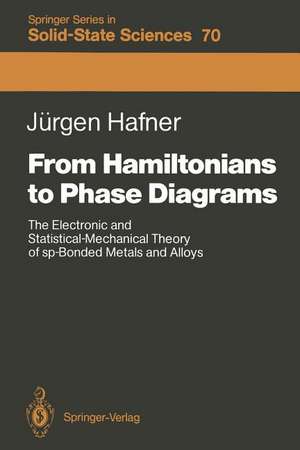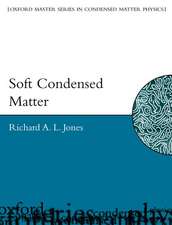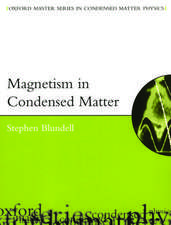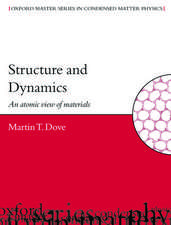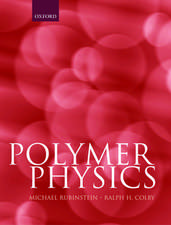From Hamiltonians to Phase Diagrams: The Electronic and Statistical-Mechanical Theory of sp-Bonded Metals and Alloys: Springer Series in Solid-State Sciences, cartea 70
Autor Jürgen Hafneren Limba Engleză Paperback – 15 dec 2011
Din seria Springer Series in Solid-State Sciences
- 18%
 Preț: 1225.94 lei
Preț: 1225.94 lei - 18%
 Preț: 1017.62 lei
Preț: 1017.62 lei - 15%
 Preț: 532.05 lei
Preț: 532.05 lei - 18%
 Preț: 944.51 lei
Preț: 944.51 lei -
 Preț: 541.46 lei
Preț: 541.46 lei - 18%
 Preț: 962.35 lei
Preț: 962.35 lei -
 Preț: 385.84 lei
Preț: 385.84 lei - 18%
 Preț: 1827.48 lei
Preț: 1827.48 lei - 15%
 Preț: 661.02 lei
Preț: 661.02 lei -
 Preț: 389.88 lei
Preț: 389.88 lei - 15%
 Preț: 639.59 lei
Preț: 639.59 lei - 15%
 Preț: 635.15 lei
Preț: 635.15 lei - 18%
 Preț: 896.21 lei
Preț: 896.21 lei - 15%
 Preț: 647.92 lei
Preț: 647.92 lei - 15%
 Preț: 651.34 lei
Preț: 651.34 lei - 18%
 Preț: 890.23 lei
Preț: 890.23 lei - 15%
 Preț: 640.55 lei
Preț: 640.55 lei - 15%
 Preț: 649.54 lei
Preț: 649.54 lei - 15%
 Preț: 645.60 lei
Preț: 645.60 lei - 15%
 Preț: 644.30 lei
Preț: 644.30 lei - 15%
 Preț: 653.79 lei
Preț: 653.79 lei - 18%
 Preț: 956.69 lei
Preț: 956.69 lei - 15%
 Preț: 637.59 lei
Preț: 637.59 lei - 23%
 Preț: 1043.41 lei
Preț: 1043.41 lei - 15%
 Preț: 639.08 lei
Preț: 639.08 lei - 15%
 Preț: 648.24 lei
Preț: 648.24 lei - 15%
 Preț: 637.46 lei
Preț: 637.46 lei - 15%
 Preț: 640.06 lei
Preț: 640.06 lei -
 Preț: 391.40 lei
Preț: 391.40 lei -
 Preț: 390.84 lei
Preț: 390.84 lei - 15%
 Preț: 638.57 lei
Preț: 638.57 lei - 18%
 Preț: 1006.06 lei
Preț: 1006.06 lei - 18%
 Preț: 730.79 lei
Preț: 730.79 lei - 15%
 Preț: 640.37 lei
Preț: 640.37 lei - 15%
 Preț: 643.65 lei
Preț: 643.65 lei - 18%
 Preț: 1231.01 lei
Preț: 1231.01 lei - 18%
 Preț: 950.21 lei
Preț: 950.21 lei - 15%
 Preț: 642.68 lei
Preț: 642.68 lei - 15%
 Preț: 640.55 lei
Preț: 640.55 lei - 18%
 Preț: 1229.10 lei
Preț: 1229.10 lei
Preț: 394.12 lei
Nou
Puncte Express: 591
Preț estimativ în valută:
75.42€ • 79.10$ • 62.78£
75.42€ • 79.10$ • 62.78£
Carte tipărită la comandă
Livrare economică 01-15 aprilie
Preluare comenzi: 021 569.72.76
Specificații
ISBN-13: 9783642830600
ISBN-10: 3642830609
Pagini: 420
Ilustrații: XI, 404 p.
Dimensiuni: 152 x 229 x 22 mm
Greutate: 0.56 kg
Ediția:Softcover reprint of the original 1st ed. 1987
Editura: Springer Berlin, Heidelberg
Colecția Springer
Seria Springer Series in Solid-State Sciences
Locul publicării:Berlin, Heidelberg, Germany
ISBN-10: 3642830609
Pagini: 420
Ilustrații: XI, 404 p.
Dimensiuni: 152 x 229 x 22 mm
Greutate: 0.56 kg
Ediția:Softcover reprint of the original 1st ed. 1987
Editura: Springer Berlin, Heidelberg
Colecția Springer
Seria Springer Series in Solid-State Sciences
Locul publicării:Berlin, Heidelberg, Germany
Public țintă
ResearchCuprins
1. Introduction.- 1.1 Why This Book Was Written and What It Contains.- 1.2 The Thermodynamic Origin of Phase Diagrams.- 1.3 Adiabatic Decoupling of the Ionic and Electronic Degrees of Freedom.- 1.4 The One-Electron Approximation.- 1.5 Tightly-Bound and Nearly-Free Electrons; Potentials and Pseudopotentials.- 1.6 Response Theory and Interatomic Interactions.- 1.7 The Statistical Mechanics of a Vibrating Lattice.- 1.8 Periodic, Aperiodic and Quasi-Periodic Structures.- 1.9 Elementary Excitations in Aperiodic Structures.- 1.10 Configurational Thermodynamics of Solids and Liquids.- 2. Interatomic Forces in Metals and Alloys.- 2.1 Pseudopotentials.- 2.2 Response Theory.- 2.3 Effective Pair Potentials in Pure Metals.- 2.4 Effective Pair Potentials in Binary Alloys.- 2.5 Interatomic Forces in Non-Simple Metals and Alloys.- 2.6 Beyond Perturbation Theory.- 3. Phase Stability of Crystalline Metals.- 3.1 Simple-Metal Cohesion.- 3.2 Structural Stability.- 3.3 Trends in Crystal Structures.- 3.4 Pressure-Induced Phase Changes.- 3.5 Thermodynamics of Crystalline Metals.- 3.6 Temperature-Induced Phase Changes.- 4. Structure and Thermodynamics of Liquid Metals.- 4.1 Computer Simulations.- 4.2 Integral Equation Approach.- 4.3 Thermodynamic Perturbation Theories.- 4.4 Trends in Liquid Structures.- 4.5 Expanded Fluid Metals.- 4.6 Structure and Thermodynamics of Liquid Transition and Rare-Earth Metals.- 4.7 Atomic Motion in Liquid Metals.- 5. The pT Phase Diagram of Pure Metals.- 5.1 Solid-Liquid Trnasitions: The Total Energy Approach.- 5.2 Microscopic Theories of Melting and Freezing.- 5.3 The Liquid-Vapour Transition.- 6. Alloy Formation and Stability.- 6.1 Nearly-Free-Electron Approach to Alloy Formation.- 6.2 Miedema’s Semiempirical Theory of Alloy Formation.- 7. Solid SubstitutionalAlloys.- 7.1 Primary Solid Solutions.- 7.2 Hume-Rothery Phases.- 7.3 Static Lattice Distortions.- 7.4 Ordering in Substitutional Alloys.- 7.5 Thermodynamics of Alloys.- 8. Intermetallic Compounds.- 8.1 Structure Maps.- 8.2 Empirical Pair-Potential Analysis of Intermetallic Phases.- 8.3 Classification of Intermetallic Phases According to Building Principles and Properties.- 8.4 Topologically Close-Packed Intermetallic Compounds (Frank-Kasper Phases).- 8.5 Intermetallic Phases with Large Band-Structure Stabilization.- 9. Liquid Alloys.- 9.1 Computer Simulations of Binary Liquid Alloys.- 9.2 Thermodynamic Variational Calculations.- 9.3 Thermodynamic Perturbation Theory.- 9.4 Structure and Thermodynamics of Liquid Transition-Metal Alloys.- 9.5 Collective Excitations in Liquid Alloys.- 10. Alloy Phase Diagrams.- 10.1 First Principles Calculations of Alloy Phase Diagrams.- 10.2 Chemical Short-Range Order and Alloy Phase Diagrams.- 10.3 Molecular Theory of the Freezing of Liquid Alloys.- 11. Beyond the Phase Diagram: The Formation and Properties of Metastable Phases.- 11.1 Amorphous Alloys — Metallic Glasses.- 11.2 Quasi-Crystals.- 12. Conclusions and Outlook.- Appendices.- A. Density-Functional Pseudopotentials.- A.1 Optimized Pseudopotentials — the Operator Approach.- A.2 Norm-Conserving Pseudopotentials — the Scattering Approach.- B. Linear Response Theroy.- C. Electrostatic Energies of Crystals and Liquids.- C.1 The Madelung Constants of the Elemental Structures.- C.2 The Madelung Constants of Binary Alloys and Intermetallic Compounds.- C.3 Electrostatic Energies of Model Liquids and Liquid Mixtures.- D. Liquid State Theory: Integral Equations, Variational Principles and Exactly Soluble Models.- D.1 Correlation Functions and Equations of State.- D.2 IntegralEquations and Variational Principles for the Total and Direct Correlation Functions.- D.3 Analytical Solutions for Model Liquids and Mixtures.- D.3.1 Solution of the PY Equation for the Hard-Sphere Fluid.- D.3.2 Solution of the PY Equation for Hard-Sphere Mixtures.- D.3.3 The Solution of the MSA for Charged Hard Spheres with Yukawa Interactions.- D.3.4 The Solution of the MSA for a Symmetric Mixture of Charged Hard Spheres with Yukawa Interactions.- References.
